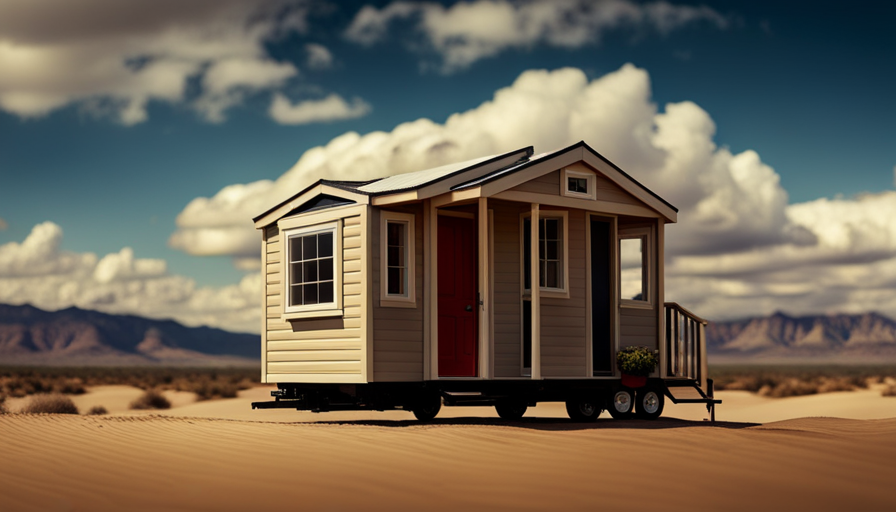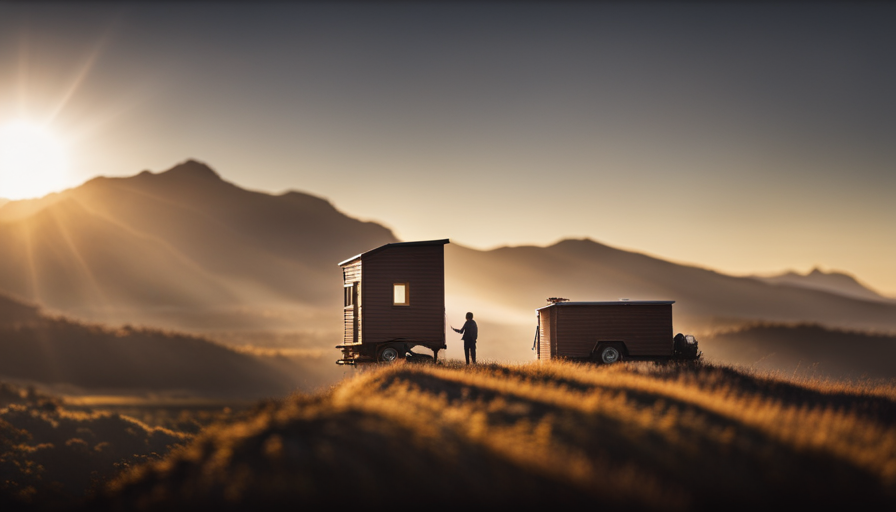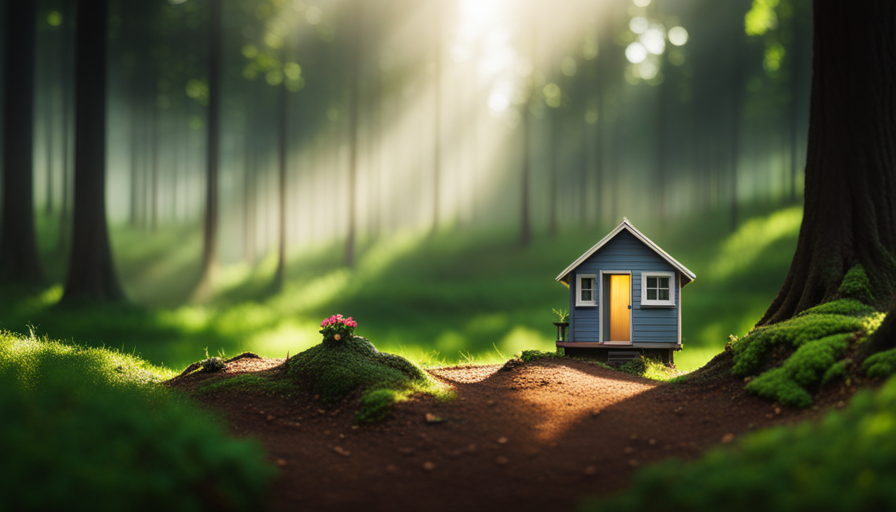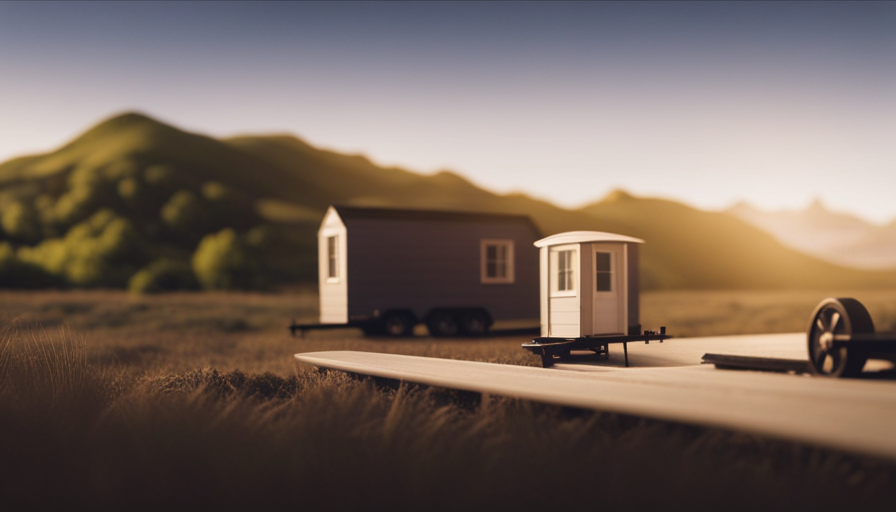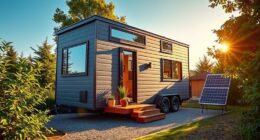Have you ever wondered how big a tiny house can get before it’s no longer considered ‘tiny’? Get ready to satisfy your curiosity, as we delve into the world of tiny house regulations, with a special emphasis on size restrictions.
As a tiny house enthusiast myself, I understand the excitement and anticipation that comes with designing and building your very own compact dream home. But before you start sketching out your floor plans, it’s important to understand the legal requirements and regulations that govern the size of a tiny house eligible for a standard license.
In this article, we will explore the various factors that need to be considered when determining the size of a tiny house, as well as provide guidance on designing a functional and efficient space. So, let’s embark on this journey together and uncover the secrets to obtaining a standard license for your tiny house!
Key Takeaways
- Minimum square footage required for a standard license ranges from 100 to 400 square feet.
- Height and width restrictions are imposed by local building codes and permits.
- Parking regulations vary by jurisdiction, with some allowing parking on private property and others requiring designated communities or RV parks.
- Designing a functional and efficient tiny house involves strategic layout planning, utilizing multipurpose furniture, maximizing storage solutions, and seeking help from professionals in small space design.
Understanding the Legal Requirements for Tiny Houses
To understand the legal requirements for your tiny house, you’ll need to familiarize yourself with the specific size regulations set by your state’s licensing authorities.
One important aspect to consider is the minimum square footage required for your tiny house to be eligible for a standard license. Each state may have different requirements, but generally, the minimum square footage ranges from 100 to 400 square feet.
Additionally, parking regulations are crucial to comply with. Some states may require your tiny house to be parked on a designated lot or within a specific zoning area. It’s essential to research and understand these regulations to ensure your tiny house meets all the necessary criteria for a standard license.
Moving on to the next section, let’s explore the size limitations for standard tiny house licenses.
Size Limitations for Standard Tiny House Licenses
When it comes to obtaining a standard license for a tiny house, there are several size limitations that need to be considered.
Firstly, there are minimum square footage requirements that must be met in order to qualify for a license.
Additionally, there are height and width restrictions that dictate the maximum dimensions the tiny house can have.
Finally, parking and zoning regulations must be adhered to in order to ensure that the tiny house is situated in a suitable location.
Minimum Square Footage Requirements
Imagine cramming yourself into a closet-sized space because that’s how small a tiny house has to be to meet the minimum square footage requirements for a standard license. When it comes to square footage guidelines, building code regulations dictate that a tiny house must have a minimum of 120 square feet of living space. This measurement does not include lofts or storage areas, which are typically found in tiny houses.
The purpose behind this minimum square footage requirement is to ensure that the living space is functional and can accommodate basic amenities such as a bathroom, kitchen, and sleeping area. However, it’s important to note that these guidelines may vary depending on the specific jurisdiction and building codes in place.
Now, let’s move on to discussing the height and width restrictions for a standard tiny house license.
Height and Width Restrictions
Get ready to feel like a giant as you navigate the height and width restrictions that come with your tiny home adventure! When it comes to building codes and obtaining building permits for your tiny house, it’s important to consider the height and width restrictions imposed by local regulations.
These restrictions vary from place to place, so it’s essential to research and understand the specific requirements in your area. Building codes typically specify the maximum height and width allowed for a structure, including tiny houses. This ensures that the structure is safe and compliant with safety standards. By adhering to these regulations, you can ensure that your tiny house meets the necessary requirements for obtaining a standard license.
Now, let’s move on to the next section about parking and zoning regulations, where we will explore another important aspect of your tiny house journey.
Parking and Zoning Regulations
Navigating through the parking and zoning regulations for your tiny home adventure will feel like maneuvering through a maze of rules and restrictions.
When it comes to parking, different jurisdictions have different requirements. Some may allow tiny homes to be parked on private property, while others may require you to find a designated tiny home community or RV park. It’s important to research and understand the parking regulations in your area before embarking on your tiny house journey.
Additionally, building codes play a crucial role in determining the size of your tiny house. These codes may dictate the minimum square footage, ceiling height, and safety features required for a standard license. Adhering to these codes is essential to ensure the legality and safety of your tiny home.
Considering these parking requirements and building codes is crucial when determining the size of your tiny house.
Transitioning into the subsequent section, it’s important to carefully evaluate these factors to ensure your tiny house meets all legal and safety standards.
Factors to Consider When Determining Tiny House Size
One important factor to consider when determining the size of a tiny house is the available space for essential amenities. Factors to consider include the number of occupants, the desired level of comfort, and the necessary appliances and fixtures.
Designing a tiny house that meets these requirements can be challenging due to the limited square footage. It’s crucial to prioritize and carefully plan the layout to maximize functionality and efficiency. This involves strategically placing furniture, utilizing multipurpose items, and utilizing vertical space.
Additionally, storage solutions must be carefully thought out to ensure that there’s enough room to store belongings without cluttering the living space. By considering these factors and overcoming designing challenges, it’s possible to create a tiny house that’s both functional and efficient.
Designing a Functional and Efficient Tiny House
To create a cozy and efficient tiny house, start by carefully planning the layout and utilizing multipurpose furniture and vertical storage solutions.
A functional layout is crucial in maximizing the limited space available. Consider open floor plans and strategically placing furniture to create distinct living areas without compromising on comfort.
Space-saving solutions are a must in a tiny house. Think about incorporating built-in storage under stairs, utilizing walls for additional shelving, and choosing furniture that can serve multiple purposes, such as a sofa that can turn into a bed.
Additionally, using vertical storage solutions, like hanging shelves or hooks, can help maximize the use of wall space.
By implementing these design concepts, you can create a functional and efficient tiny house that feels spacious and comfortable.
When it comes to working with professionals and experts, their expertise can guide you in making the most of your tiny space.
Working with Professionals and Experts
Working with professionals and experts can be an invaluable resource in optimizing the functionality and design of your tiny home. When it comes to designing a tiny house, working with architects who specialize in small space design can ensure that every inch of your home is utilized efficiently. They can help you come up with innovative solutions and make the most of limited space. Additionally, involving experts in budgeting considerations can help you stay within your financial limits and avoid unexpected expenses. They can provide guidance on cost-effective materials, energy-efficient systems, and smart design choices that will save you money in the long run. By working with professionals and experts throughout the design process, you can create a tiny home that meets your needs and budget. Transitioning into the next section about navigating the permitting and approval process, it is crucial to understand the regulations and requirements involved in legally establishing your tiny house.
Navigating the Permitting and Approval Process
After working with professionals and experts in the field, I felt confident in my plans for my tiny house. But little did I know, navigating the permitting and approval process would present its own set of challenges.
One of the biggest hurdles I faced was ensuring that my tiny house complied with all the building codes and regulations set by the local authorities. From minimum square footage requirements to safety considerations, there were many hoops to jump through. I had to carefully review the building codes and make sure my design met all the necessary criteria. It was a time-consuming and sometimes frustrating process, but I knew that building code compliance was essential to obtaining a standard license for my tiny house.
With all the necessary permits in hand, I was ready to move forward and explore the resources and support available for tiny house enthusiasts.
Resources and Support for Tiny House Enthusiasts
Explore the various resources and support available to you as a tiny house enthusiast, helping you to navigate the challenges of building and living in a tiny house. When it comes to building a tiny house, there are a multitude of resources available to assist you every step of the way. From design and construction plans to workshops and online forums, these resources can provide valuable guidance and inspiration. Additionally, financing a tiny house can be a daunting task, but there are options available to help make it more affordable. Some resources include tiny house lending programs, crowdfunding platforms, and grants specifically for tiny house projects. By utilizing these resources, you can ensure that you have the support and information necessary to successfully build and finance your own tiny house.
| Resource | Description | Website | ||||
|---|---|---|---|---|---|---|
| Tiny House Design | Offers a wide range of design plans and ideas for tiny houses | www.tinyhousedesign.com | ||||
| Tiny House Workshop | Provides hands-on workshops and courses on building tiny houses | www.tinyhouseworkshop.com | ||||
| Tiny House Community | Online forum where tiny house enthusiasts can connect and share information | www.tinyhousecommunity.com | Tiny House Marketplace | A platform where people can buy and sell tiny houses, as well as find resources and support for building and living in a tiny home | www.tinyhousemarketplace.com | |
| Tiny House Design Services | Professional design services for those looking to build their own custom tiny house, offering personalized floor plans and interior design options | www.tinyhousedesignservices.com | ||||
| Tiny House Rentals | A website that allows people to rent out their tiny homes for short-term stays, providing a unique and eco-friendly vacation experience | www.tinyhouserentals.com | ||||
| Tiny House DIY Kits | Pre-designed and pre-cut DIY kits that include all the necessary materials and instructions for building your own tiny house, making it easier for beginners to get started | www.tinyhousediykits.com | ||||
| Tiny House Sustainability Guide | An online resource offering tips, tricks, and advice on how to live sustainably in a tiny house, including information on renewable energy options, water conservation, and eco-friendly materials | www.tinyhousesustainabilityguide.com | ||||
| Tiny House Blog | A blog dedicated to showcasing and discussing different tiny house designs, interior decor ideas, and stories of people living in tiny homes, providing inspiration and guidance for aspiring tiny house owners | www.tinyhouseblog.com |
Frequently Asked Questions
Can I legally live in a tiny house on my own property without a standard license?
Yes, I can legally live in a tiny house on my own property without a standard license, as long as I comply with zoning regulations. These regulations dictate where and how I can place my tiny house on my property. It is important to research and understand the specific zoning laws in my area to ensure that my tiny house is in compliance. Local authorities will have the final say on the legality of living in a tiny house on my property.
Are there specific restrictions on the height of a tiny house for a standard license?
I must mention that specific height limitations for a tiny house vary depending on the jurisdiction and local building codes.
However, it’s important to note that alternative housing options like tiny houses often have height restrictions to ensure safety and compliance with regulations. These restrictions are in place to prevent issues such as structural instability and potential hazards.
Therefore, it’s crucial to research and adhere to the specific height limitations set by your local authorities before constructing a tiny house.
What are the consequences of building a tiny house that exceeds the size limitations for a standard license?
Building a tiny house that exceeds the size limitations for a standard license can have serious consequences and legal implications. It may result in fines, penalties, or even legal action taken against the owner.
Building codes and regulations exist for a reason, ensuring safety, structural integrity, and proper land use. By disregarding these size limitations, individuals risk violating the law and facing the aforementioned consequences.
It’s essential to adhere to the size restrictions set by the licensing authorities to avoid legal complications.
Is it possible to modify an existing structure, such as a shed or garage, to meet the requirements for a standard tiny house license?
Modifying existing structures, such as sheds or garages, to meet the requirements for a standard tiny house license can be a viable option. However, it’s essential to consider the legal implications involved. Building codes and regulations vary from jurisdiction to jurisdiction, so it’s crucial to consult with local authorities to ensure compliance.
Additionally, modifications must adhere to safety standards, including proper insulation, ventilation, and structural stability. Seeking professional guidance is recommended to navigate the process successfully.
Are there any specific guidelines or regulations for the location or placement of a tiny house on a property?
There are specific regulations for the location and placement of a tiny house on a property. These regulations outline the requirements, restrictions, and size limitations for where a tiny house can be placed.
It is important to consider these guidelines when deciding on the placement of a tiny house. Failure to comply with these regulations can have consequences, such as fines or the need for modifications to existing structures to meet the necessary requirements.
Conclusion
In conclusion, embarking on the journey of building a tiny house requires careful consideration of legal requirements, size limitations, and design factors.
Just like a skilled painter meticulously chooses their brushes and colors to create a masterpiece, so must we carefully select the elements that will make our tiny house functional and efficient.
Working with professionals and experts will ensure that our vision becomes a reality, while navigating the permitting and approval process can be likened to sailing through uncharted waters.
Thankfully, there are abundant resources and support available to guide us on this exciting adventure of tiny house living.
Hi, I’m Emma. I’m the Editor in Chief of Tiny House 43, a blog all about tiny houses. While tree houses are often associated with childhood, they can be the perfect adult retreat. They offer a cozy space to relax and unwind, surrounded by nature. And since they’re typically built on stilts or raised platforms, they offer stunning views that traditional homes simply can’t match. If you’re looking for a unique and romantic getaway, a tree house tiny house might just be the perfect option.
